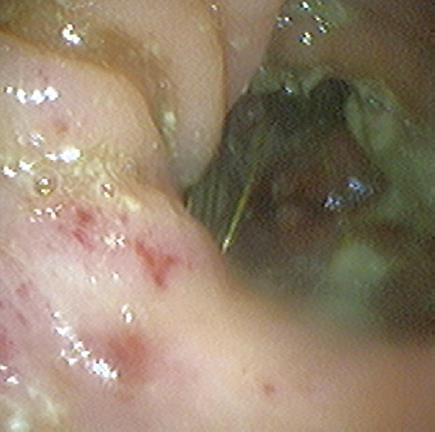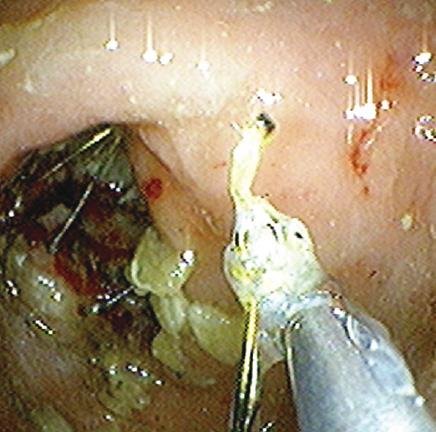Published online Feb 16, 2010. doi: 10.4253/wjge.v2.i2.75
Revised: August 1, 2009
Accepted: August 8, 2009
Published online: February 16, 2010
We report the first case of trimming of a migrated metal colonic stent for stent induced severe anorectal pain. We present a case of a 54-year-old female with history of metastatic colorectal carcinoma who had stent placement secondary to obstruction. Subsequent distal migration of the stent caused ulcerations into the rectal mucosa and excruciating anorectal pain. We used argon plasma coagulation (APC) to successfully trim the exposed distal portion of the metal stent and rat tooth forceps to retrieve the stent fragments. The use of APC for trimming metallic stents is an effective procedure that can be used to trim migrated rectal stents that result in significant rectal pain. To date, few studies have been published that use APC to trim metallic stents placed in the gastrointestinal tract. To the best of our knowledge, ours is the only known case in which the indication for stent trimming was severe stent induced rectal pain. The procedure resulted in complete relief of patient symptoms. Therefore, APC is a safe and effective way to trim colo-rectal stents to definitively relieve the symptom of stent induced rectal pain in patients who have experienced distal stent migration and mucosal ulceration.
- Citation: Rao KV, Beri GD, Wang WW. Trimming of a migrated metal stent for malignant colonic stricture using argon plasma coagulation. World J Gastrointest Endosc 2010; 2(2): 75-76
- URL: https://www.wjgnet.com/1948-5190/full/v2/i2/75.htm
- DOI: https://dx.doi.org/10.4253/wjge.v2.i2.75
Malignant obstruction of the colon occurs in 7%-25% of patients with colorectal carcinoma[1]. Over the last decade, colorectal stenting has been reported as an alternative to emergency laparotomy to relieve acute colonic obstruction[1]. Complications of colorectal stenting include tenesmus, transient anorectal pain, rectal bleeding, colonic perforation and even stent migration[2]. We present a case of a 54-year-old female with history of metastatic colorectal carcinoma who had stent placement secondary to obstruction. Subsequent distal migration of the stent caused erosions into the rectal mucosa and excruciating anorectal pain. We used Argon Plasma Coagulation (APC) to successfully trim the exposed distal portion of the metal stent. We report the first case of trimming of a migrated metal colonic stent for stent induced severe anorectal pain.
A 54-year-old female initially presented with a 6 mo history of blood per rectum with alternating constipation and diarrhea, and a 20 pound unintentional weight loss. On colonoscopy, the patient was found to have an adenocarcinoma of the transverse colon for which a hemicolectomy with diverting colostomy was performed. The patient was also noted to have a fixed adenocarcinoma of the rectum. Subsequently, chemo-radiotherapy was started but discontinued due to patient intolerance. She presented 5 mo later with persistent abdominal pain, nausea, and vomiting.
A colonoscopy was performed which revealed a tumor mass obstructing her rectum and a mesh rectal metallic stent (Z stent) was placed to palliate the obstruction. A few months later the patient presented to the GI clinic complaining of severe rectal pain. Flexible sigmoidoscopy revealed multiple areas of rectal ulceration secondary to erosion of the distal stent mesh into the rectal mucosa (Figure 1). APC was used (35 watts and 2 Liters flow rate) to successfully trim the distal 1 cm of the Z stent. The trimmings were retrieved using rat tooth forceps (Figure 2).
The use of APC for trimming metallic stents is an efficient procedure that can be used to trim migrated rectal stents that result in significant rectal pain. To date, few studies have been published that use APC to trim metallic stents placed in the gastrointestinal tract. Most cases of stent trimming with APC have been reported in metallic biliary stents that have migrated distally[3,4]. Two cases have been reported where a colonic stent was trimmed using APC for the treatment of tenesmus[5]. To the best of our knowledge, ours is the only known case in which the indication for stent trimming was severe rectal pain and upon subsequent follow up a few days later, the patient was entirely pain free. Therefore, APC is a safe and effective way to trim colo-rectal stents to definitely relieve the symptom of pain in patients who have experienced distal stent migration and mucosal ulceration.
Peer reviewer: Rungsun Rerknimitr, MD, Associate Professor, Division of Gastroenterology, Department of Medicine, Chulalongkorn University, Rama IV Rd., Bangkok 10330, Thailand
| 1. | Repici A, Pagano N, Hervoso CM, Danese S, Nicita R, Preatoni P, Malesci A. Metal stents for malignant colorectal obstruction. Minim Invasive Ther Allied Technol. 2006;15:331-338. |
| 2. | Pericoli Ridolfini M, Sofo L, Di Giorgio A, Gourgiotis S, Di Miceli D, Alfieri S, Doglietto GB. [Late complication after colon self-expandable metal stent placement: a case report]. Minerva Chir. 2007;62:69-72. |
| 3. | Vanbiervliet G, Piche T, Caroli-Bosc FX, Dumas R, Peten EP, Huet PM, Tran A, Demarquay JF. Endoscopic argon plasma trimming of biliary and gastrointestinal metallic stents. Endoscopy. 2005;37:434-438. |
| 4. | Chen YK, Jakribettuu V, Springer EW, Shah RJ, Penberthy J, Nash SR. Safety and efficacy of argon plasma coagulation trimming of malpositioned and migrated biliary metal stents: a controlled study in the porcine model. Am J Gastroenterol. 2006;101:2025-2030. |
| 5. | Witte TN, Danovitch SH, Borum ML, Irani SK. Endoscopic trimming of a rectal self-expanding metallic stent by use of argon plasma coagulation. Gastrointest Endosc. 2007;66:210-211. |










